Clear Soup with Clam is an elegant soup and is often served at special occasions such as the Doll Day festival on 3rd March. The soup is packed with the great flavour of the clams. Clear Soup with Clam is surprisingly easy to make.
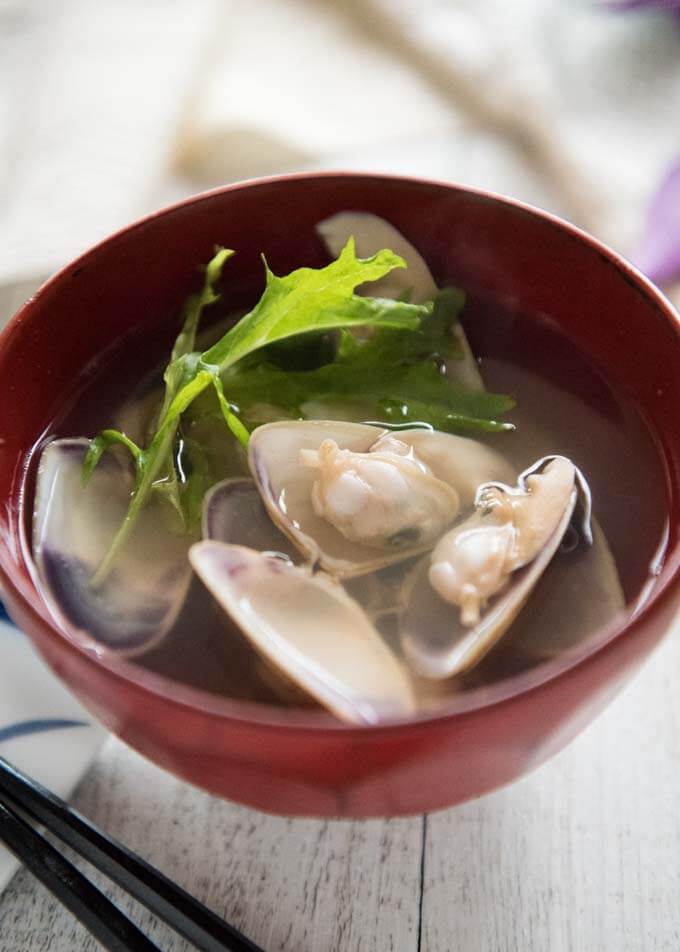
I called the shells in this soup ‘clams’, but in Australia, most common clam shells are pipi and vongole. I used pipis today since they are very similar to the clam that are used to make today’s dish in Japan.
Different Types of Clams
In Japan, there are three commonly consumed clams. They are ‘hamaguri’ (蛤 or はまぐり), ‘asari’ (浅蜊 or あさり) and ‘shijimi’ (蜆 or しじみ).
The shell of the hamaguri is smooth on the surface and very similar to that of the pipi, but hamaguri shells often have geometric patterns on them. The size of the hamaguri is usually larger than the pipi and the large ones are as big as half of your palm.
The size of asari is slightly smaller than pipi. The shell has a grid surface like vongole and comes in different colours and patterns.
Shijimi is the tiniest of the three. Unlike hamaguri and asari, shijimi lives in fresh water and the shell is black. The size of shijimi is half of pipi or even smaller. The tiniest shijimi, about 1cm / ⅜” is often used to make dashi stock out of them.
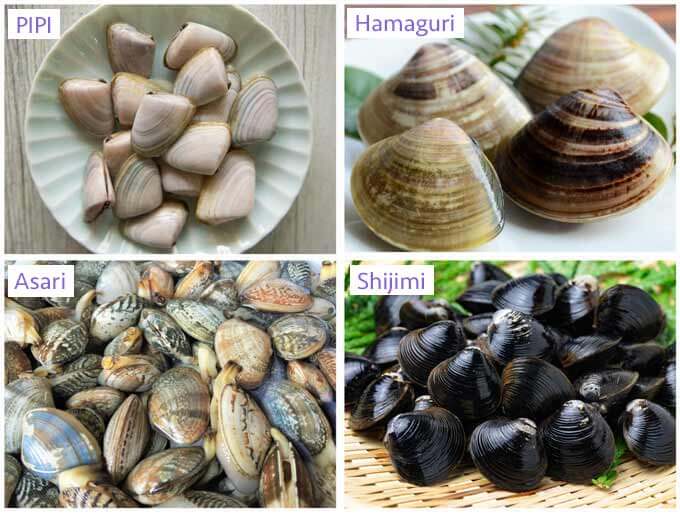
I am sure there are many different kinds of clam shells in the world and you may not be familiar with any of the shells I mentioned above. But as long as the shells are edible clams and the size of the shell is anywhere between 2.5cm / 1” and 5cm / 2”, they are suitable for Clear Soup with Clams.
The size of the clams that I mentioned is just a guide. Any smaller might be awkward to eat the meat off each shell and the larger shells simply do not fit in a serving bowl nicely.
Preparing shells for Clear Soup with Clams
These days, clams sold at fish shops don’t have much sand inside the shells. But I do go through the process of removing any sand that might still be inside.
Leave the clams in 3-4% salt water (similar to the sea water) for 1 hour. The water level is just below the surface of the clams so that they can breathe.
If your country allows you to pick clams from the beach (not in Australia any more) and you picked clams instead of buying from the shop, you need to leave them in salt water for ½ day as they contain much more sand inside.

If you can, put the clams in a sieve, a strainer or a rack, then place it in a bowl or a tray of salt water. The reason for using a sieve or a rack is that the sand that came out of the shells collects below it which prevents the clams from sucking the sand again.
After this, you need to clean the surface of the shells. Take a handful of clams at a time, rub the shells against each other inside your hands with running water to clean the surface of the shells.
Making Clear Soup from Clams
I have posted several clear soup recipes – Japanese Style Egg Drop Soup, Shrimp Balls in Clear Soup, Dried Tofu Skin Soup, Ozōni (Clear Soup with Rice Cake), Japanese Clear Soup with Whiting.
The broth of these clear soups is made from bonito flakes. But to make today’s clear soup, you don’t use bonito flakes. The clams themselves become the basis of the dashi stock.
Simply place the clams in a pot with water, with a piece of konbu (dried kelp) if you want and bring it to a boil. Simmer until the clams are all opened. You will notice that the soup becomes slightly whitish. That’s the dashi stock with clams already in it.
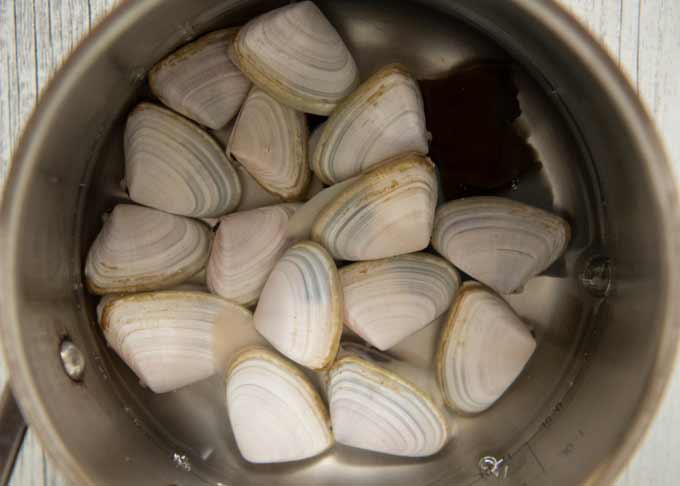
Add sake, light soy sauce and salt to adjust the flavour at the end and the soup is ready.
About Ushiojiru (潮汁)
The clear soup made by boiling water with shells or fish (white meat), which also becomes the ingredient of the soup, is called ‘ushiojiru‘ (潮汁). Flavouring of ushiojiru is usually just salt but a bit of sake and soy sauce might be added to it, especially when using shells.
It is said that ushiojiru was originally a fishermen’s soup. Freshly caught fish was cooked in a pot filled with sea water. The word ‘ushio‘ (潮) means tide or sea and ‘jiru‘ (汁) is the same as ‘shiru‘, meaning soup as in ‘misoshiru’ (味噌汁) – miso soup.
To distinguish the different types of ushiojiru, the soups are named by adding a word at the beginning that represents the ingredients.
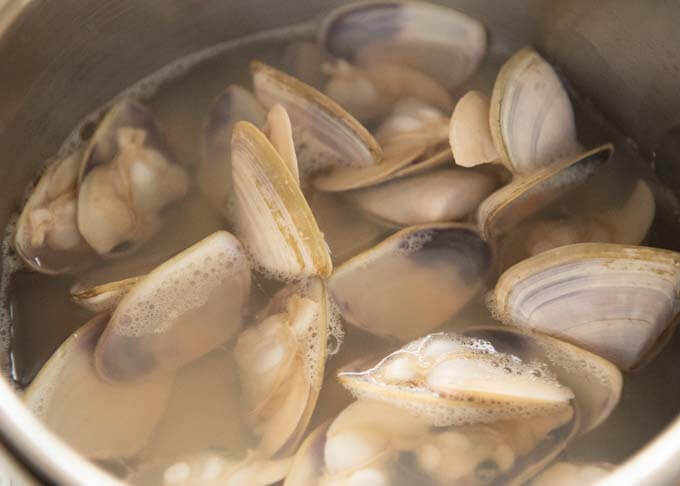
In the case of today’s soup, it is called ‘hamaguri no ushiojiru‘ (蛤の潮汁). The word ‘no’ is equivalent to ‘with’ in this context. If made with snapper, it is called ‘tai no ushiojiru‘ (鯛の潮汁). I must post tai no ushiojiru one day.
Serving Clear Soup with Clam
Clear Soup with Clam is served with a touch of green colour added to it almost without exception (otherwise it is rather bland). Any small leaf such as mizuna, as per my recipe, mitsuba (Japanese parsley), spinach or Asian greens would be fine.
I would not use green leaves with a strong flavour, e.g. green part of shallot/scallion, as the flavour of the soup and clam is so delicate.
Depending on the size of the clams, the number of shells per bowl varies. In Japan when hamaguri is used in this soup, you sometimes only get a couple of large hamaguri. It is particularly so when served on special occasions.
I think that the smaller the number of the clams, the larger the clams need to be, and the bowl of soup looks fancier.
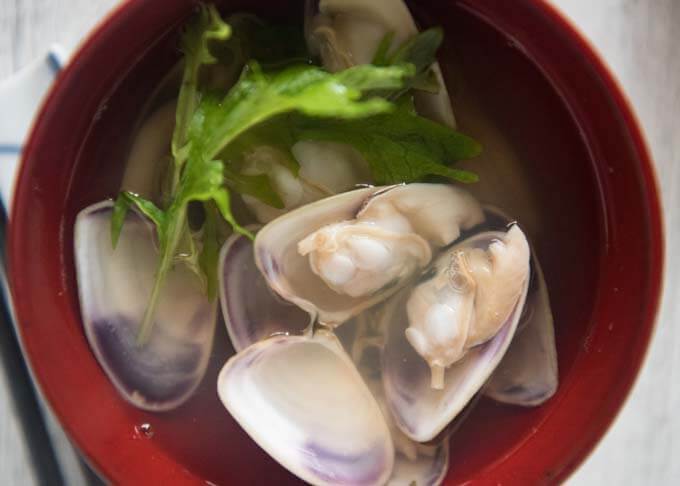
Note: If the shell in the soup is not opened, discard. It was probably dead before cooking and you wouldn’t know how long it had been dead for.
My pipis are too small to serve only a couple of them in a bowl. And my cooking is not for a special occasion, so I served about half a dozen pipis per bowl.
It takes only 10 minutes to make Clear Soup with Clam. It would go perfectly well with almost any kind of dish in my view. So, I hope you try it.
Yumiko![]()
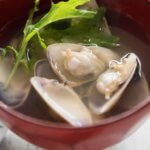
Clear Soup with Clam is an elegant soup and is often served at special occasions such as the Doll Day festival on 3rd March. The soup is packed with the great flavour of the clams. Clear Soup with Clam is surprisingly easy to make.
PS: I added a new section ‘MEAL IDEAS’ below the recipe card. It gives you a list of dishes that I have already posted and the new recipe in this post that can make up a complete meal. I hope it is of help to you!
- 200g / 7.1oz live clams/pipis , sand removed (note 1)
- 500ml / 1.1pt water
- 5cm2 / 2” 2 konbu (Dried Kelp, optional)
- 1 tbsp cooking sake
- ⅛ tsp light soy sauce
- Salt to adjust flavour
- Mizuna leaves (note 2)
-
Take a handful of clams at a time, rub the shells against each other inside your hands with running water to clean the surface of the shells.
-
Put water, konbu, then clams in a pot and heat over medium low heat (note 3).
-
When the water starts boiling, remove the konbu and reduce the heat to low.
-
When the clams are all opened, turned the heat off. If there is white bublly scam on the surface, remove.
-
Add sake and soy sauce to the pot and gently mix. Taste test and add a pinch of salt or two if required.
-
Heat the soup with the clams again just before serving. Serve in a bowl (note 4) with a small mizuna leaf.
1. I used pipis as shown in the post because they are always available in Sydney.
Clams are often sold as 'no sand' at fish shops. But if you are still concerned, leave the shells in 3-4% salt water for 1 hour. The water level is just below the surface of the clams so that they can breathe.
If you can, put the clams in a sieve, a strainer or a rack, then place it in a bowl or a tray of salt water so that the shells will not suck in the dropped sand again.
If your clams appear to have a lot of sand, you need to leave the clams in the salty water for ½ day.
2. Other than mizuna, commonly used green garnishes are mitsuba (Japanese parsley), spinach or Asian greens. Do not use green leaves with strong flavour, e.g. shallots/scallions.
3. If you have time, leave the konbu in the 500ml / 1.1pt water 30 minutes before cooking so that more flavours from the konbu will be extracted.
4. If the shell is not opening, discard as it was probably dead before cooking and you wouldn't know how long it had been dead for.
5. Nutrition per serving.
serving: 363g calories: 98kcal fat: 1g (2%) saturated fat: 0.2g (1%) trans fat: 0.0g polyunsaturated fat: 0.2g monounsaturated fat: 0.1g cholesterol: 30mg (10%) sodium: 711mg (30%) potassium: 54mg (2%) carbohydrates: 4.4g (1%) dietary fibre: 0.1g (0%) sugar: 0g protein: 15g vitamin a: 6% vitamin c: 0.3% calcium: 4.3% iron: 9.9%
Meal Ideas
A typical Japanese meal consists of a main dish, a couple of side dishes, a soup and rice. I try to come up with a combination of dishes with a variety of flavours, colours, textures and make-ahead dishes.
Clear Soup with Clam is often served on Dolls Day with Scattered Sushi (Chirashi Sushi). So I came up with a list of dish that are perfect for a special day to celebrate.
The most luxurious looking simmered dish has to be Chikuzenn-ni so I picked it for a side dish. Since it is for the special occasion, I included a dessert!
- Main: Scattered Sushi (Chirashi Sushi)
- Side dish 1: Chikuzenni (Simmered Chicken and Vegetables) – make ahead
- Side dish 2: Broccolini Karashi-ae (Mustard Dressing) – alternatively, Spinach Ohitashi Salad
- Soup: Clear Soup with Clam – today’s recipe
- Dessert: Okinawan Sundae – make ahead Brown Sugar Syrup
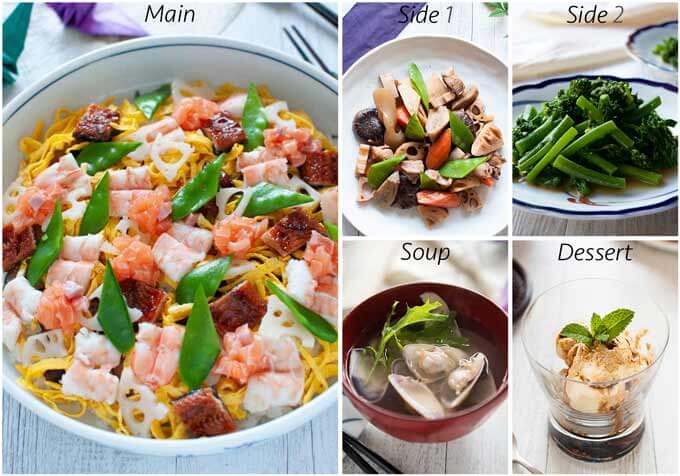
Leave a Reply